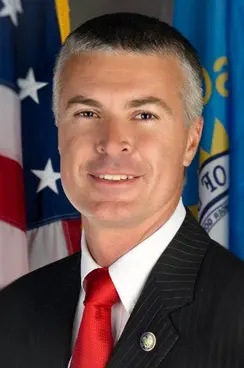In a surprising move that has sparked widespread debate, South Dakota Governor Kristi Noem is proposing significant financial cuts to South Dakota Public Broadcasting (SDPB). This comes at a pivotal time as she awaits confirmation to lead the U.S. Department of Homeland Security, raising concerns about the potential impact on critical communication infrastructure within the state.
The proposed budget cut, outlined in Noem’s December 3rd budget address, aims to slash more than $3.6 million from the SDPB’s $5.6 million in state funding. This decision has raised alarms among various state and federal agencies that rely heavily on SDPB’s vast network of 45 towers for emergency communication across South Dakota.

Gov. Kristi Noem
SeVern Ashes, SDPB’s director of engineering and operations, highlighted that the cuts would jeopardize the station’s ability to maintain vital infrastructure and services. “The funding left would be insufficient to support infrastructure, engineering salaries, buildings, power, or service contracts for the equipment,” he explained. It currently costs an estimated $4.8 million annually to keep their comprehensive engineering services operational.
SDPB is a critical part of the state’s emergency response system, operating 45 towers, of which 17 host equipment essential for public safety communication. Not only do state and local agencies, including the South Dakota Division of Criminal Investigation and local police departments, rely on these towers, but major telecommunication companies such as Verizon, T-Mobile, and AT&T also lease space for their operations.
The network’s importance extends to federal agencies like U.S. Immigration and Customs Enforcement, the FBI, the U.S. Forest Service, and the Federal Aviation Administration, which also utilize the SDPB towers for communication, especially crucial when managing emergencies such as forest fires in the Black Hills.

Marty Jackley
South Dakota Attorney General Marty Jackley, who has a rich background in both electrical engineering and law, emphasized that public broadcasting is crucial for public safety alerts. “We rely on it to a great degree for public safety from weather conditions to missing children and endangered individuals,” he stated. Jackley is no stranger to public service, holding positions from U.S. Attorney for the District of South Dakota to Attorney General of South Dakota.
The SDPB’s infrastructure is integral not only to broadcasting but also as the state’s connection to the federal Emergency Alert System, covering every county in South Dakota. Any disruption poses significant risks, affecting the state’s ability to issue Amber Alerts, Blue Alerts, and other critical communications statewide.
Critics suggest that Governor Noem’s motivations may be aligned more with political ideologies, particularly her opposition to National Public Radio (NPR), a part of SDPB programming that often challenges conservative viewpoints.
Ryan Howlett, CEO of Friends of South Dakota Public Broadcasting, voiced concerns about the safety implications for the nearly 1 million residents depending on reliable emergency broadcasts and communications facilitated by SDPB’s network. “The bottom line is that Noem’s proposed cut will compromise the safety of about 1 million people,” he warned.
Many in South Dakota are left questioning the rationale behind endangering such a vital communications network at a time when Noem herself is poised to head Homeland Security, a role that intrinsically values robust, reliable emergency communication systems.
As this situation develops, it illustrates a broader narrative about balancing fiscal policies with the imperatives of public safety and access to information in South Dakota’s unique socio-political landscape.